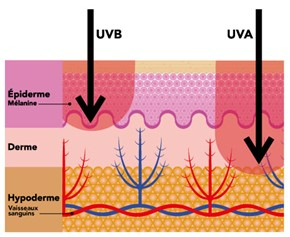Summer is just around the corner, and many of us are looking forward to getting a nice tan. But what does the sun do to our skin, really? What’s the cost of a golden complexion? Let’s have a look at the different types of rays and their effects on our health.
The effects of UV rays on skin
The impacts of ultraviolet rays on living cells are significant. UV radiation directly affects physiology and often causes irreparable damage.
Some rays burn skin, acting as a warning system of sorts to avoid overexposure to the sun. Some give it colour, while others damage epidermal DNA and cause cancer. Excessive exposure to these rays has a negative impact on the skin’s immune system.
Can sunrays improve skin’s appearance?
You may have heard that sunlight is good for certain conditions , like psoriasis, vitiligo and lupus vulgaris. While it’s true that the sun may temporarily improve the skin’s appearance, it still has long-term undesirable side effects. It’s best to enjoy the sun in small doses and remember that too much can actually make these conditions worse.
Spring: Here comes the sun—and the sunscreen!
After being cooped up all winter, we can’t wait for spring to arrive so we can head outside and recharge our batteries. But we need to be careful before soaking up all that sun. Our skin hasn’t been exposed to strong sunlight for some time, so it doesn’t have a protective base tan and is particularly vulnerable to UV rays. Spring is the most critical time for skin damage.
Think that a sunburn will protect your skin for the rest of the summer, and that you’ll be able to tan worry-free afterward? Think again. Sunburns just cause inflammation and accelerate aging. To make the most of the warmer days ahead, a good sunscreen is your best ally.

UVC… What’s the difference?
The sun produces three main types of UV rays , each with their own characteristics and health impacts.
UVA rays darken the skin
UVA wavelengths fall between 320 nm and 400 nm. The UV radiation that reaches the Earth’s surface is mostly UVA. These rays penetrate into the mid-dermis and rapidly tan skin when it’s exposed to the sun. They stimulate melanin synthesis and turn skin golden without necessarily burning it, making them the ideal tool for tanning salons. However, while UVA rays may provide an immediate tan, it fades quickly.
These rays contain cancer-causing free radicals, which have toxic effects. UVA rays damage elastin and collagen fibres, which give the skin elasticity and firmness; as a result, they’re also responsible for premature aging.
UVB rays cause sunburns
UVB wavelengths are 290 nm to 320 nm. About 2% of the UV radiation reaching the Earth’s surface is UVB. These rays destroy epidermis cells, which induces the release inflammatory mediators that cause the redness and pain of sunburns. They also stimulate the development of melanin, producing a longer-lasting tan that appears 48 to 72 hours after exposure.
Over the long term, UVB rays can damage skin cell DNA, increasing the risk of cancer.
UVC rays have the shortest wavelength (190 nm to 290 nm); they’re very high energy and quite harmful to living cells. In fact, hospitals use them for their germicidal properties, because they can destroy DNA. Fortunately, the ozone layer blocks the sun’s UVC rays.
UVC rays are rare but harmful
UVC rays have the shortest wavelength (190 nm to 290 nm); they’re very high energy and quite harmful to living cells. In fact, hospitals use them for their germicidal properties, because they can destroy DNA. Fortunately, the ozone layer blocks the sun’s UVC rays.

Proper sun protection
Did you know that 80% of skin damage is linked to solar radiation and blue light? Dark spots, wrinkles, dehydration, leathery skin, rosacea, vascular lesions, dilated pores, dark circles, sagging, cancer… Overexposure to UV rays undermines biological integrity and has many unpleasant consequences.
As soon as skin reddens, it’s a sign of damage. To see the long-term effects of the sun for yourself, compare a part of your body that has never been exposed to sunlight with one that is regularly exposed. You should be able to spot differences in texture, thickness and colour.
Our Biocompatible Care® can help counter the side effects of sun exposure, but prevention is the best defence. Proper protection is a must to enjoy the sun safely.
Choosing the right sunscreen
To protect your skin, be sure to use the best product. Many of the sunscreens on the market contain chemical filters. These may limit the damage that the sun’s rays can cause, but they’re also bad for your skin’s health and appearance, and the environment. To help you make the right choice, pick up our paper checklist of toxic agents to avoid while you’re making your purchases.
Sunbrella™: 100% natural, moisturizing and anti-aging sunscreens
Our line of innovative Sunbrella™ sunscreens help keep your skin young by preventing sun-induced aging. They contain minerals, moisturizers and natural antioxidants, and they don’t have any chemical filters or preservatives. In addition to being made in Quebec, our sun care products feel great on your skin and leave no white residue.
The Sunbrella™ line consists of three products:
Translucent, water-resistant and ethical powder sunscreen in three shades
Translucent, water-resistant and ethical sunscreen for the face in two shades
Translucent, water-resistant and ethical body sunscreen .
The facial sunscreen protects, hydrates and prevents aging. This lightly tinted, eco-friendly cream gives you a luminous complexion while hiding imperfections. You no longer need to choose between sunscreen and makeup! Its anti-aging ingredients also protect your skin against oxidative stress from the sun’s rays, blue light and pollution. Give your face a healthy glow!
With properly applied sun protection, you can fully enjoy the sunshine and its vitamins. Summer is a time to play, but keep UV rays at bay!
